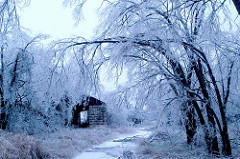Released: Jan. 20, 2017
After the ice storm: Tending to damaged trees
K-State horticulture expert offers tips for determining what to do with trees affected by the ice storm that hit Kansas last weekend

MANHATTAN, Kan. – After the ice storm that struck Kansas last weekend, many people – especially in the middle of the state – are dealing with damaged trees. Ward Upham, extension associate for Kansas State University, said tree damage often leaves homeowners with a decision about whether a tree can be saved.
For those facing that choice, as well as cleaning up plenty of fallen limbs, the first step is to wait until all the ice has melted.
“Slippery ice and chainsaws don’t mix,” said Upham, home horticulture rapid response coordinator for extension agents across Kansas and the state extension Master Gardener coordinator. “Check for downed power lines or hanging branches. Don't venture under the tree until it is safe. If large limbs are hanging precariously, a certified arborist has the tools, training and knowledge to do the work safely.”
The next step is to remove debris to avoid tripping over it.
After that, a careful examination of the tree is necessary to decide if saving the tree is feasible. Upham provided this checklist of steps to make that decision and give surviving trees the best chance to thrive:
- Decide whether it is feasible to save a tree. If the bark has been split so the cambium is exposed or the main trunk split, the tree probably will not survive and should be removed. If there are so many broken limbs that the tree’s form is destroyed, replacement is the best option.
Topping, where all the main branches are cut and there are only stubs left, is not a recommended pruning procedure. Though new branches will normally arise from the stubs, they are not as firmly attached as the original branches and more likely to break in subsequent storms. Also, the tree must use a lot of energy to develop new branches, leaving less to fight off diseases and insect attacks. Often, the topped tree's life is shortened. - Prune broken branches to the next larger branch or to the trunk. If cutting back to the trunk, do not cut flush with the trunk but rather at the collar area between the branch and the trunk. Cutting flush with the trunk leaves a much larger wound than cutting at the collar and takes longer to heal. Middle-aged or younger, vigorous trees can have up to one-third of the crown removed and still make a surprisingly swift comeback.
- Take large limbs off in stages. If you try to take off a large limb in one cut, it will often break before the cut is finished and strip bark from the tree. Instead, first make a cut about 15 inches from the trunk. Start from the bottom and cut one-third of the way up through the limb. Make the second cut from the top down but start 2 inches further away from the trunk than the first. The branch will break away as you make the second cut. The third cut, made at the collar area, removes the stub that is left.
Upham also noted that pruning can be dangerous. “Consider hiring a trained, certified arborist to do major work,” he said. “Also, a good arborist knows how to prune trees so that storm breakage is less likely to occur. Preventing damage is better than trying to fix it once it has happened.”
For more information about tree care and more, subscribe to the K-State Research and Extension Horticulture Newsletter: www.ksuhortnewsletter.org. An audio interview with Ward Upham speaking on the radio show Agriculture Today is available at http://www.ksre.k-state.edu/news/radio-network/agtoday-mp3/011917-upham.mp3
Upham also recommends the Arbor Day Foundation website, which contains detailed information about dealing with storm damage: www.arborday.org/media/stormindex.cfm
-30-
K‑State Research and Extension is a short name for the Kansas State University Agricultural Experiment Station and Cooperative Extension Service, a program designed to generate and distribute useful knowledge for the well‑being of Kansans. Supported by county, state, federal and private funds, the program has county Extension offices, experiment fields, area Extension offices and regional research centers statewide. Its headquarters is on the K‑State campus in Manhattan.
Story by:
Jason Hackett jhackett@ksu.edu
K-State Research and Extension
www.ksre.ksu.edu
For more information:
Ward Upham - 785-532-1438 or wupham@ksu.edu
